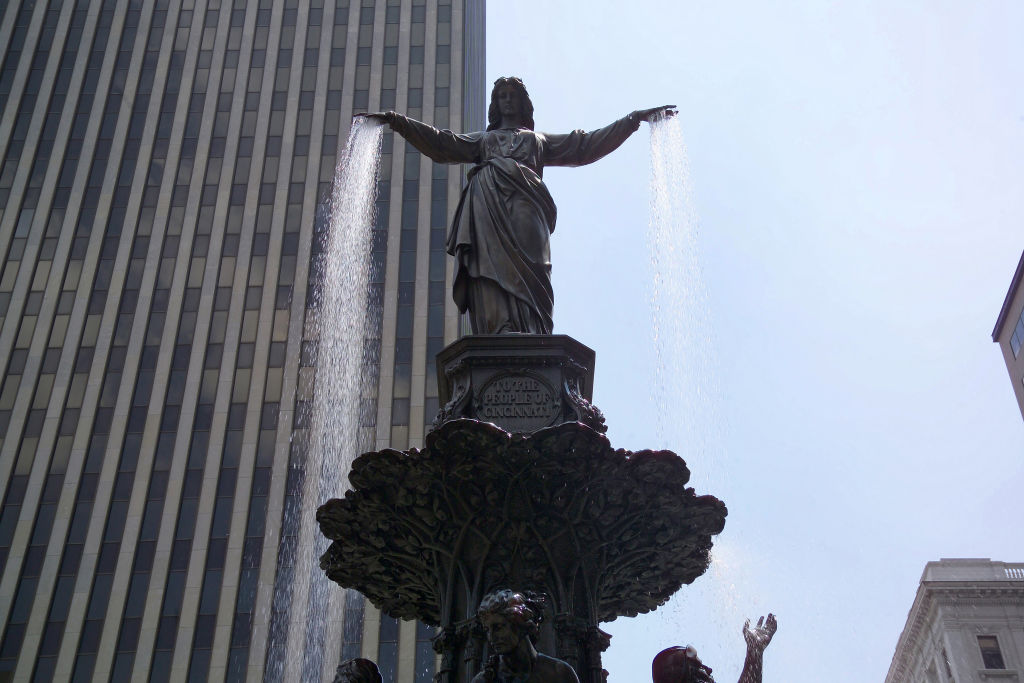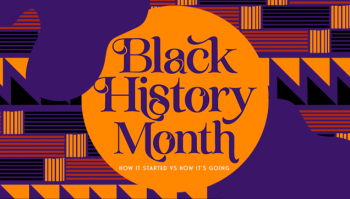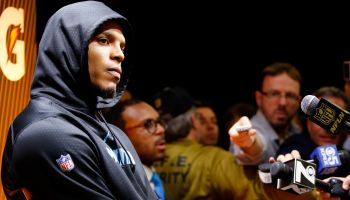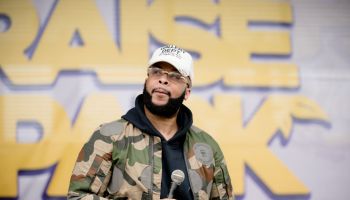
Source: Tom Szczerbowski / Getty
Yes it’s Black History Month and we learn about Martin Luther King, Rosa Parks and all of the great pioneers. But have you thought about the people that were trailblazers and making black history in Cincinnati?
There are so many hidden stories within our community that happened on the streets we walk every day. We didn’t want these precious stories to be lost so we decided to share a series called Cincinnati’s Black Pearls: Rare Gems, No Longer Hidden.
Let’s celebrate our legendary ancestors that came before us and hope you enjoy these stories.
Henry Boyd: 1802 to 1886
In 1832, as the cholera epidemic raged through Cincinnati, Henry Boyd, a furniture maker and formerly enslaved told The Enquirer how to stop the spread. “Mr. Henry Boyd… suggested that the source of cholera is in the water, and that it may be removed by boiling ….” Boyd understood what doctors didn’t – that cholera was transmitted person to person through infected water. While his advice was ignored and the disease killed three percent of the city’s population, his ideas went on to influence later epidemiologists eventually wiping out the disease.
Reference: Henry Boyd’s Early Life in Kentucky
Courtesy of Cincinnati History Library and Archives
Eliza Potter: ?1820 to 1893
In 1859 on the eve of the Civil War, Eliza Potter, beautician to Cincinnati’s white elite published her tell-all memoir, A Hairdresser’s Experience in the High Life. The secrets this free black woman revealed about the lifestyles of the rich and famous captivated the public and put her white clientele on notice. Decades before Madame C.J. Walker, Potter was a pioneer of black entrepreneurship and in writing this norm-breaking book, achieved something even more remarkable: a black woman as the lead character of her own story.
Reference: Santamarina, Xiomara and Eliza Potter, A Hairdresser’s Experience in High Life. The University of North Carolina Press, 2009. Project MUSE muse.jhu.edu/book/19116
Granville Woods: 1856 to 1910
If you’ve ever traveled on a streetcar or subway, you have Cincinnati’s own Granville Woods to thank. With over fifty U.S. patents, Woods, also known as the “Black Edison”, earned his first patent in Cincinnati. Woods is credited with making safe subway travel in New York City a reality. After a lifetime of legal battles trying to protect his patents from theft, he died impoverished and forgotten, but not any more.
References:
Dabney, Wendell. Cincinnati’s Colored Citizens. 1926.
https://www.nytimes.com/interactive/2019/obituaries/granville-t-woods-overlooked.html
Robert Duncanson: 1821 to 1872
Robert Duncanson was a self-taught painter of landscapes who achieved international acclaim in his lifetime. Born in New York, his fine arts career flourished in Mt. Healthy, which in the 1830s and 1840s was a vibrant arts community with the largest free black population in the West. Duncanson was inspired by the landscapes of the Hudson River Valley School and created his own movement, the Ohio River Valley landscape tradition. His painting “Landscape with Rainbow” is the first painting by a black artist to hang in the White House.
References:
https://nkythrives.com/inthenews/CITN-Robert-S-Duncan-Landscape-with-Rainbow-White-House.aspx
Dabney, Wendell. Cincinnati’s Colored Citizens. 1926.
Ezzard Charles: 1921 to 1975
Despite being the World Heavyweight Champion from 1949 until 1951, appreciation for Ezzard Charles’ contributions to boxing remained elusive. Criticized for lacking “the killer instinct,” he favored a relentless training schedule and cerebral tactics over brute force in the ring. What sportswriters of his time missed, other boxers admired. Rocky Marciano called him the toughest challenger he’d ever faced. Charles once said, “[I’m] just a simple, square soul of a fellow, who believed in playing the game by the rules. But if I had to do it over again, I wouldn’t change a thing.”
References:
http://library.cincymuseum.org/aag/bio/charles.html
Powhatan Beaty: 1837 to 1916
Born into slavery, Beaty moved to Cincinnati in 1849 and unlike others who were conscripted into Civil War service at knife point, Beaty willingly enlisted. He fought with the Black Brigade and was quickly promoted through the ranks eventually winning the Medal of Honor, the military’s highest decoration, for bravery in battle. Rather than destroy him, the trauma of war found its release in the tragedies of Shakespeare and Beaty became a renowned actor of the classic tragedies, eventually acting in productions in the Ford Theater in Washington, D.C.
References:
https://www.battlefields.org/learn/biographies/powhatan-beaty
https://en.wikipedia.org/wiki/Powhatan_Beaty
Doctor Lucy Oxley: 1912 to 1991
The lone woman and the first African American woman to earn a medical degree from the University of Cincinnati Medical School, Dr. Oxley was refused an internship at General Hospital (now University) because she was black. The decision to become a doctor, said Oxley, “was chosen for me. I was a doctor from the day I was born.” She eventually established a family practice in Walnut Hills that became a fixture in the community. About the many challenges racism posed, Dr. Oxley said, “…it’s bias, it’s hatred, it’s the devil himself.”
George Washington Williams: 1849 to 1891
Williams was the first African American to serve in the Ohio General Assembly and was credited with writing the first history (and still considered to be among the most significant) of African Americans in 1882, History of the Negro Race. Although born free, he had little education, other than “learning about Jesus.” He eventually graduated from Harvard. Williams sought to refute, not only by the example of his life, but also in his writings, that there were any biological differences among races. In investigating the transatlantic slave trade for his writing, he was the first to expose the “brutal imperialism” of Belgian rule and the colonization of the Congo. In writing about this and slavery, he coined the timeless phrase “crimes against humanity.”
Reference:
http://werehistory.org/williams/
Margaret Garner: 1834 to 1858
The headline read: “A Slave Mother Murders her Child rather than see it returned to Slavery.”
On January 27th, 1856, Margaret, her husband and four kids crossed from Covington to Cincinnati on foot on a river frozen over with ice. They hoped to leave behind a life of slavery in Boone County and eventually find their freedom in Canada. But in Cincinnati, they were captured by U.S. Marshals and under the Fugitive Slave Act, were to be returned to their master, Archibald Gaines. Rather than allow her children to be returned to slavery, Margaret stabbed them and herself just as Marshals charged the cabin in which they were hiding. One child died, but the others survived.
Garner’s trial became one of the longest and most sensational in American history and, as the Cincinnati Gazette of January 31, 1856 noted: “No Colored persons were admitted within the courtroom.”
Her destiny hinged on how she would be tried. Would she be tried for the murder of her child (and thereby be recognized as a free woman?) or would she be tried as an escaped slave under the Fugitive Slave Act (and be classified as property)? In a bitter disappointment to Garner and her advocates, she was tried as an escaped slave (i.e property) under the Fugitive Slave Act, was found guilty and was returned to slavery.
Her story has been the basis of many scholarly and artistic works, including Beloved, a Pulitzer prize winning book by Ohio’s own Toni Morrison.
Reference: http://library.cincymuseum.org/aag/bio/garner.html
Frederick Suggs: ? to 2002
In 1955, Frederick Suggs, began publishing the local forerunner to Ebony Magazine called NIP magazine. Published from 1955 to 1979, NIP Magazine included images rarely represented in the media – local African Americans in Vanity Fair style layouts, dressed in elegant tailored three-piece suits and Halston dresses. Decades before US News and World Report, NIP Magazine contained profiles and rankings of HBCUs and consumer reports on African American businesses.
References: http://library.cincymuseum.org/aag/general.html#nip
Jennie Davis Porter: 1876 to 1936
After graduating from Hughes High School in 1893, Porter established a private kindergarten for African American children in the West End. Her passion for teaching prompted her to help establish The Harriet Beecher Stowe school, later becoming the first African American principal in Cincinnati. The school became renowned for strong academics and attracted African Americans moving north during the Great Migration. Her curriculum included both vocational and academic studies. She was a controversial figure, advocating for a black only school, reasoning that learning was more effective in an environment free from racism. She met with opponents in the African American community who felt her views were counterproductive in the fight for equality. She was the first African American to earn a Doctorate from UC.
Reference:http://library.cincymuseum.org/aag/bio/porter.html
James Presley Ball: 1825 to 1904
Imagine having not one but three accomplished careers (photographer, abolitionist, politician) at a time when slavery was legal and when conveniences such as electricity and indoor plumbing were unheard of. James Presley Ball managed all of these professions in an era of sobering obstacles. Growing up at a time when African Americans were represented by caricature, Ball opened a photography studio in Cincinnati in 1849 and earned acclaim by devoting himself to the dignified representation of his people. He welcomed Frederick Douglass and Ulysses S. Grant into his studio for portraits and grew to such wide acclaim that he eventually traveled to Europe to photograph the likes of Queen Victoria and Charles Dickens. Toward the end of his life, he relocated to Montana, entered politics and ran for several Republican offices while continuing to photograph a changing frontier of new immigrants, settlements and public executions.
The Ball Special Collection at the Cincinnati Museum Center represents the largest collections of images by Ball and partners.
Reference: http://library.cincymuseum.org/ball/jpball.htm
Frank A.B. Hall: 1870-1934
The son of formerly enslaved parents, Hall came to Cincinnati in 1892 and opened a lunch stand in Walnut Hills. The stand not only served food, but became a perch from which Hall could keenly observe the comings and goings of his neighborhood. In a short time, he was appointed a sub-patrolman of the Cincinnati Police Department. He steadily rose the law enforcement ranks eventually retiring as a detective, the city’s first African American in this role, in 1926. In 1931, in another first, he served a two year city council term. From 1922 to 1926, Hall was, president of Mercy Hospital from 1922 to 1926.
Reference: http://library.cincymuseum.org/aag/bio/hall.html
Wendell Phillips Dabney: 1865-1952
Dabney’s father, formerly enslaved, taught his son two life-changing skills: to cook and to expect a higher standard of living than the culture at large said was his due. After the Civil War, his father opened a catering business allowing Dabney to graduate high school and later attend Oberlin College where he excelled in music – learning to play the violin, mandolin, and banjo. Although a star student, Dabney was forced to leave college after one year to work as a waiter to help support his family. He eventually settled in Cincinnati and became a music teacher for prominent white families. As the first local president of the NAACP, he understood that key issues in the African American community needed representation in the media so he started a newspaper called The Ohio Enterprise, which was published from 1907 to 1952. He wrote a seminal catalog of Cincinnati’s African American population called Cincinnati’s Colored Citizens in 1926, which is a treasure trove of local history.
Reference:
http://library.cincymuseum.org/aag/bio/dabney.html
Horace Sudduth: 1888 to 1957
Born in Covington, Sudduth understood that to establish African Americans as community stakeholders meant securing their real estate footprint. Establishing real estate and savings and loan companies, Sudduth and his team, were single-handedly responsible for moving hundreds of African Americans into home ownership throughout Walnut Hills and the West End – all during the era of Jim Crow. Called “our real estate agent” by newspaper publisher, Wendell Dabney, Sudduth made the dream of black property ownership a reality.
Reference:
https://walnuthillsstories.org/stories/horace-sudduth-single-family-homes/
Reference:
https://nkaa.uky.edu/nkaa/items/show/277
Jesse Dwight Locker: 1891 to 1955
Born and raised in College Hill, Locker graduated from College Hill High School and eventually went to law school at Howard University in Washington, DC. He served six consecutive city council terms, resigning in 1953. He was thereafter recruited by U.S. President Eisenhower to serve as ambassador to the West African coastal nation of Liberia.
Reference:
https://www.newspapers.com/clip/42639350/the-cincinnati-enquirer/
DeHart Hubbard: 1903 to 1976
A graduate of Douglass Elementary, the Stowe School, Walnut Hills High School and the University of Michigan (with Honors), Hubbard became the first African American to win an Olympic Gold medal. His event was the running long jump during the 1924 Paris Summer games. He went on to break his own record and shattered the world record a year later, jumping 25 feet 10.75 inches in Chicago. After his victories, he worked for the recreation commission and eventually for the Federal Public Housing Authority in Cleveland.
Reference:
http://library.cincymuseum.org/aag/bio/hubbard.html
Robert Harlan: 1816 to 1897
While Harlan’s mother was enslaved, his rumored father was the prominent white Kentucky Judge James Harlan, who raised and educated Harlan with his own children. Harlan did not receive his freedom until 1848, purchasing it from his former owner and suspected father. An able entrepreneur, he opened a barber shop, then a grocery store and amassed the wealth to first buy a race horse and then an entire stable. In 1858, he brought his champion thoroughbreds to England proving his worth as a competitive force in international racing and enjoying a respite from the prejudice he faced back in the U.S. During the Gold Rush, he opened a trading store in San Francisco and built a fortune. He returned to Cincinnati after the death of his wife and young daughter and invested much of his wealth into local real estate.
Reference:
https://africanamericanhorsestories.org/research/people/robert-harlan
Virginia Coffey: 1904 to 2003
This civil and human rights leader was born to parents who demanded an integrated education for their children. Graduating from Western Michigan University with degrees in education and sociology, Coffey moved to Cincinnati in the 1920s and was shocked by a profoundly segregated city. She left teaching and joined forces with the NAACP to work on issues of racial justice. Coffey was instrumental in removing racial restrictions from restaurants, businesses and public facilities such as the swimming pool at Owl’s Nest Park in O’Bryonville (in 1950) and Coney Island (in 1961).
Reference:
http://library.cincymuseum.org/aag/bio/coffey.html
Peter Clark: 1829 to 1925
Born in Cincinnati to a barber father who worked for his child to have a private school education, Clark
dreamed of starting a printing press. White press owners refused to train him and Clark reluctantly returned to his father’s profession of barbering to earn a living. His father only served white clientele. When Clark opened his business to African Americans, his white clientele left and with them the business. He later found work as a grocer with an uncle who mentored him in continuing to fight for the rights of African Americans. Clark eventually committed his life to education and eventually becoming a principal of an elementary and high school. He believed in a segregated education primarily as a means for African American teachers to join the educational work force, as integrated schools rarely offered African Americans employment.
Reference:


















